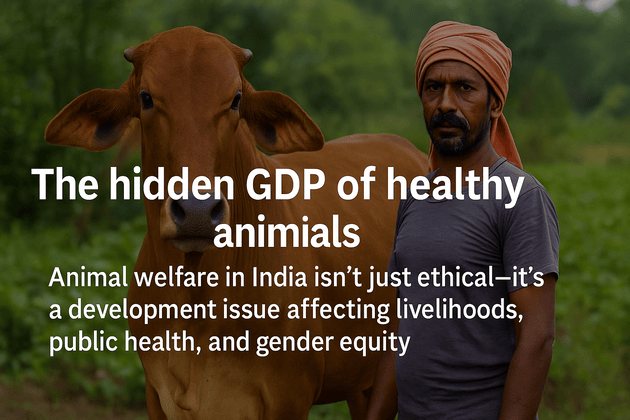
The hidden GDP of healthy animals


Animal welfare in India isn’t just ethical—it’s a development issue affecting livelihoods, public health, and gender equity
In Development as Freedom (1999), Amartya Sen argued that freedom is both the means and the end of development, urging us to look beyond income-based metrics to assess well-being. Though focused on human capabilities, Sen's ideas offer valuable insights into animal welfare, particularly in settings where humans and animals coexist closely, as is common in India's rural and urban landscapes. In this context, advancing animal well-being is not just an ethical obligation but a developmental necessity.
India has over 62 million stray dogs, many living in and around human settlements. They form informal but significant parts of local communities, interacting with people, pets, and livestock. This proximity introduces complex challenges at the intersection of animal welfare, public health, and rural livelihoods. The One Health framework—recognising the interconnectedness of human, animal, and environmental health—provides a powerful lens to address these issues in an integrated manner.

The missing freedoms in animal welfare
The Five Freedoms of animal welfare, developed by the UK Farm Animal Welfare Council, mirror Sen’s idea of removing “unfreedoms.” These include freedom from hunger, discomfort, pain, fear, and the ability to express natural behaviour. Unfortunately, these freedoms remain aspirational for many stray and working animals in India. Diseases, malnutrition, and neglect persist—not due to apathy, but due to gaps in service delivery resources, public awareness, and integrated planning.
Among the most visible threats is rabies, a zoonotic disease that causes approximately 20,000 human deaths annually in India and is almost always fatal once symptoms appear. Recognising its severity, the Government of India initiated the National Rabies Control Programme (NRCP), complemented by the internationally funded Mission Rabies, launched in 2013 by the Worldwide Veterinary Service (WVS). Using mobile veterinary units, dog population management, mass vaccination, and school-based awareness campaigns, the initiative achieved significant milestones—most notably, zero human rabies deaths for five years in Goa since 2017, leading to the state’s declaration as a Rabies Controlled Area in 2021.

The hidden burden of parasitic diseases
While rabies garners attention, a larger but less visible threat to both animal and human health lies in ectoparasites (ticks, fleas, lice) and endoparasites (worms, flukes, protozoa) that afflict both strays and farm animals. These parasitic infections cause chronic illness, stunt animal productivity, and enable the spread of zoonotic diseases such as toxocariasis, giardiasis, and hydatid disease. Animals act as carriers, shedding parasite eggs in their faeces or transferring ticks through close contact with other animals. For livestock, this transmission impacts milk-producing cattle, meat animals, and poultry, often devastating farm incomes.
The economic consequences of parasitic disease are considerable. According to academic research, internal parasitic infections alone can reduce milk yield by 10–15%, while weight loss in meat animals can reach 30%, affecting market value. Tick infestations may cause a ₹61 per day milk loss per cow, and treating tick-borne diseases like babesiosis can cost ₹500–₹1,500 per animal. For smallholder households, particularly those with 2–5 animals, these cumulative losses—estimated at ₹5,000–₹15,000 annually per animal—pose serious threats to livelihood security.

This burden is disproportionately borne by women, who comprise the backbone of India’s dairy and small ruminant economy. Many women in livestock care are landless or marginal farmers, often managing animals in resource-constrained environments. For them, livestock is not just a productive asset but a buffer against food insecurity, a source of household nutrition, and often the only form of movable capital. A disease outbreak, loss of productivity, or animal death can destabilise entire household economies, pushing families into debt or distress sales.
Towards integrated, gender-sensitive solutions
While there is no single national mission for parasite control akin to Mission Rabies, valuable building blocks are in place. Programmes like the National Animal Disease Control Programme (NADCP) and the Rashtriya Gokul Mission incorporate deworming and disease surveillance into broader livestock health strategies. Coordinated integration of these existing programmes—through synchronised deworming drives, farmer training, mobile veterinary outreach, and community-based surveillance—can significantly reduce the burden of parasitic infections.

Furthermore, establishing Veterinary Public Health Clinics focused on One Health principles can create the infrastructure for long-term, systemic change. These clinics would provide preventive services such as vaccination, deworming, tick control, and animal birth control while monitoring zoonotic threats and working closely with human health and environmental agencies. Veterinary extension workers trained in participatory methods could ensure these services reach the last-mile farmer, especially women.
At its heart, this approach requires not just veterinary science or economic logic but empathy. Recognising that animal welfare and rural development are two sides of the same coin allows us to design more inclusive, effective policies. As Sen reminds us, freedom is not merely about choices but the capability to live a life of dignity. Extending that idea to animals—and the women and farmers who care for them—requires a holistic commitment to coexistence, shared responsibility, and systems thinking.
Reimagining animal health as human development

In conclusion, animal health must be reimagined as a core component of human development, particularly in rural India, where livelihoods, nutrition, and resilience depend on healthy animals. Through coordinated programmes, gender-sensitive policies, veterinary infrastructure, and One Health integration, we can unlock lasting benefits for animals and the millions of rural families who depend on them.
No Techcircle journalist was involved in the creation/production of this content.

Ekaa Desai and Ashish Desai
Ashish Desai is an Associate Professor of Information Management and Analytics at the S.P. Jain Institute of Management and Research (SPJIMR), and Ekaa Desai is a BVSC & AH student at Mumbai Veterinary College.
